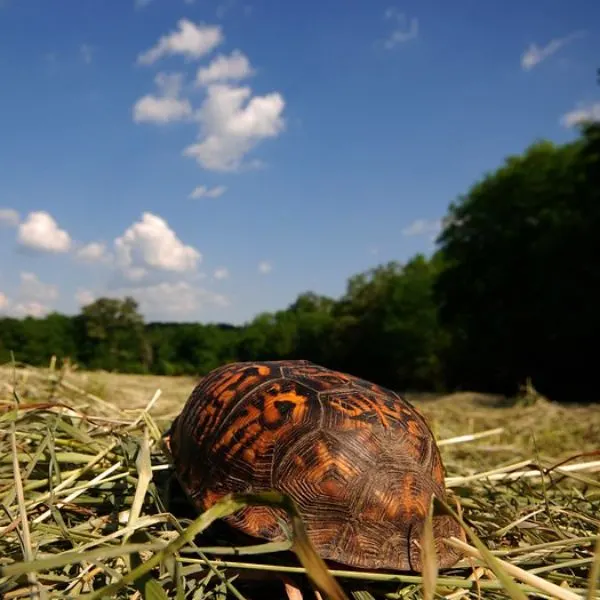Ever wonder how much box turtles cost?
Box turtles are among the most popular pets. But before you get one, ‘How much do box turtles cost?’ Box turtles are known for being hardy and easy to care for.
They are long-lived and do not require an expensive setup. While they are capable swimmers, they are better housed in a terrarium rather than an aquarium which is less expensive and easier to maintain.
When getting a pet, it is important to remember that cost includes not just buying the turtle but also providing an enclosure as well as the initial feeding and veterinarian fees. It is essential to consider all of these costs before going out to buy a box turtle.
Box turtles may be easy to care for but can you afford the care? We will detail the cost in this article.
Table of Contents
The Cost of Only the Box Turtle
The first thing we have to tackle is the cost of the chelonian. If you already have a setup and everything that the turtle needs. Then this may be the only cost you are concerned about. I can tell you straight away the average cost of a box turtle. Currently, the lowest a box turtle should cost you is around $50. The highest you should expect to pay for a normal box turtle is $300.
However, the price of the box turtle ranges. Different species and subspecies are priced differently. The pricing is determined by their availability as well as the demand for the turtle. There is also a shipping cost to consider if you plan on buying a box turtle that isn’t available where you live.
Other factors that will affect the price are the size and age of the chelonian.
Overall, the rarer the species, the more expensive it will be. Here are some box turtle species usually kept as pets and their respective prices. These prices are estimates and can change from one store to another.
- Eastern Box Turtle (Terrapene carolina carolina) – $30 to $150
- Chinese Box Turtle (Cuora flavomarginata) – $350 to $650
- Three-Toed Box Turtle (T. c. triunguis) – $100 to $400
- Desert Box Turtle (Terrapene ornata luteola) – $300 to $500
- Asian Box Turtle (Cuora) – $150 to $300
- Florida Box Turtle (T. c. bauri) -$100 – $450
- Ornate box turtle (Terrapene ornata ornata) – $150 – $450
- Indonesian Box Turtle (Cuora amboinensis) – $50 to $30
- McCord Box Turtle (Cuora Mccordi) – $10,000
Box turtles are usually readily available and can be found in most pet shops that sell tortoises and turtles. However, if you are particular about the species you want or if you want a rare species you may need to get in touch with a breeder.
Some sites that allow you to buy from breeders include lllreptile.com, and backwaterreptiles.com.
The Cost of Setting up the Box Turtle Habitat
Even before you bring your turtle home you need to set up the enclosure. This includes acquiring the enclosure. This can be a tortoise table, a terrarium, or even an outdoor enclosure. You need substrate in the enclosure, heating, lighting, and an adequate humidity level.
Enclosure

The enclosure type depends on the type of box turtle you acquire. Most box turtles are terrestrial with the Coahuilan box turtle being the only aquatic box turtle out there. Since all the others are terrestrial, we will discuss setting up a terrestrial enclosure.
The enclosure can be challenging as you may need to build one yourself.
Here are some measurements to get you started. The enclosure should be at least 4 ft by 4 ft. the walls should be 10 inches underneath the ground to prevent the turtle from burrowing out. Box turtles like to burrow.
You also need to provide a water box for the turtle. You also need to provide several hiding spots for the turtle.
Whether or not you are housing the turtle outdoors, they need to be inside when the temperatures drop during the winter.
I recommend getting a tortoise table if you want to buy just a single turtle. A large tortoise house such as Rockever Tortoise House should cost about $150 – $250.
A shallow water and food dish should cost less than $10. You will need a separate bowl for water and a separate bowl for food.
- Enclosure – $150 to $250
- Food and Water Dishes – $10 to $20
Substrate

Since this is a terrarium, you need substrate in the enclosure. There are a lot of choices out there. You cannot go wrong. Personally, I recommend substrates that retain moisture. This helps to control the humidity levels within the enclosure. If the turtle is housed in an outdoor pen, you may need a lot of substrates.
I recommend substrate over just the ground as the ground can be gritty and cause intestinal impaction. A mix of peat moss, sphagnum moss, and dampened topsoil also works. However, to simplify things, I recommend you go with one of the substrates mentioned before.
You can go with aspen shaving, eco earth, or coco coir for the tortoise box.
- Substrates – $20 to $30
Heating

Heating is essential. As you may know, turtles aren’t warm-blooded. These creatures are cold-blooded and their body temperature is dictated solely by the temperature of their surroundings. Providing your boxie with enough heat ensures that it is active and feeds properly.
You need a heat lamp if you live in a place where temperatures aren’t high enough. Most of the turtles mentioned already require basking temperatures of around 90 degrees Fahrenheit. In many temperate zones, temperatures rarely are that high consistently.
The heat lamp is also needed over the basking spot. The cool end can have temperatures in the low 70 degrees.
Install a turtle heating kit over the turtle’s enclosure. The Zoo Med Aquatic Turtle UVB Heat Lighting Kit is an excellent choice. This kit provides the heat lamp and the lamp holder. This can then be placed over the turtle’s enclosure.
I recommend you get a ceramic heat lamp. These do not produce light and as such will not disturb the turtle and can be turned on on cold nights. The OMAYKEY Ceramic Heat Lamp is an excellent choice here.
As time goes on, the heat lamp will not provide the required amount of heat and will need to be changed. Having a thermometer around is a handy wait to keep track of the temperatures within the enclosure. Analog thermometers are slightly cheaper than digital thermometers. My picks are the REPTI ZOO Digital Terrarium Thermometer and the REPTI ZOO Terrarium Thermometer Dual Gauges (this is analog).
The analog thermometers with gauges usually do not require batteries while the digital thermometers do.
These thermometers are practical and provide good estimates of temperatures within the enclosure but if you want an accurate reading, I recommend you get a thermometer gun such as the Etekcity Infrared Thermometer whenever you wish to doublecheck the temperature within the enclosure.
- Heating Kit – $20 to $30
- Two thermometers that have inbuilt hygrometers – $20 to $30
- Heat Lamp – $15
Lighting

The next thing to worry about is lighting. Like other turtles, boxies require ultraviolet radiation to synthesize vitamin D3 which is essential in the bone development of the turtle. Natural sunlight provides the turtle with UVA and UVB radiation. This not only ensures that the turtle is healthy but also ensures that the turtle is active.
When kept in an enclosure, you need to install UV light lamps over the enclosure. The Zoo Med Aquatic Turtle UVB Heat Lighting Ki mentioned earlier has a holder for both the heat lamp and the UV lamp.
The Reptisun is also an excellent choice. Most people prefer Reptisun to any other UV lamp out there. They are efficient and produce the required UV radiation any box turtle will require. An alternative to the Reptisun is the LUCKY HERP UVB/UVA 10.0 bulb.
These bulbs have to be changed regularly as their UV output reduces over time. I recommend changing them every six or so months.
You may also want to acquire a few UV sensors. These allow you to measure the UV output of the Uv lamps you acquire. These should cost you a couple of bucks apiece. You can get about two to start with.
- Light bulb – $15 to $20
- UV Sensor – $5 to $10
Humidity

Getting the humidity levels right can be challenging. Some box turtles such as the Asian box turtle, Indonesian box turtle, and the Florida box turtle require high humidity levels to thrive. With the Florida box turtle. Humidity levels need to be 70 to 90 percent.
Other box turtles such as the common box turtle require humidity levels of about 60%. The species you have will determine the humidity levels you should try and target.
Getting a humidity gauge is the first step. If you live in a humid part of the world, the humidity levels may be in the right range. The thermometers mentioned earlier have hygrometers built-in. These should be excellent for a box turtle enclosure.
So what can you do if humidity levels are low? There are a few options available to you. The first is getting a reptile humidifier such as the COOSPIDER Reptile Humidifier.
Another option is to acquire a mist spray bottle designed for increasing humidity within a reptile/amphibian terrarium such as the Exo Terra Spray Bottle.
- Humidifier/Spray Bottle – $15 to $55
Initial Cost of Feeding the Turtle

Box turtles may look and act like tortoises but they are not tortoises. When it comes to feeding, box turtles are predominantly carnivorous. As they grow, they become more omnivorous. You are going to have to feed these reptiles foods high in protein.
Most recommend that the box turtle’s diet should be about 60% protein.
These turtles accept gastropods (canned snails), pinkie mice, silkworms, wax worms, earthworms, roaches, crickets, mealworms, and crustaceans.
The turtles also accept meat. I recommend feeding them 93% lean meat.
The diet of the box turtle should be composed mostly of protein and vegetables. They accept plants such as duckweed, romaine lettuce, collard greens, and dandelion greens. This should make up about 40% of the turtle’s diet.
Young box turtles need to be fed about once a day initially.
Apart from the foods, you also need to supplement the food with calcium supplements twice a week. Fluker’s Calcium and Vitamin D Supplement is a good choice.
You can also choose to feed your turtle commercial diets such as Fluker’s Turtle Food, Rep-Cal Box Turtle Food, Reptomin, and Nutrafin Max Gammarus.
- Initial Food Cost – $20
- Supplement – $10
Medical Costs

Once you have acquired your turtle, you need to see the veterinarian. Even if your turtle looks well, the first checkup is very important. This will allow the veterinarian to determine the health of the turtle.
You will also need to do annual checkups. This is the best way to ensure that your turtle lives a healthy long life.
There are extra costs in case your turtle is ill, however, if you keep the enclosure clean, feed them well, and provide adequate UV radiation, humidity levels, and heat, the turtle should remain healthy. The unexpected costs would not be included here.
Regarding the health of the turtle, annual veterinarian checkups are a must. These costs are included here. A checkup usually costs anywhere between $45 and $80.
- Checkup – $45 to $80
Overall Average Cost Of Obtaining A Box Turtle
| The turtle (the price of rare and expensive turtle such as the McCord Box turtle not included) | $30 to $650 |
| Enclosure | $150 to $250 |
| Food and Water Dishes | $10 to $20 |
| Substrates | $20 to $30 |
| Heating Kit | $20 to $30 |
| Thermometers | $20 to $30 |
| Heat Lamp | $15 |
| Light Bulb + UV sensor (optional) | $15 to $30 |
| Humidifier/Spray Bottle | $15 to $55 |
| Initial Food Cost + Supplements | $30 |
| Checkup | $45 to $80 |
| Total Average Cost | $370 to $1220 |
The initial cost of a box turtle should range anywhere from $370 to $1220. Of course, if you wish to get a rare turtle such as the McCord box turtle, add about $10,000 to the cost.

Conclusion
When it comes to the cost of a box turtle, most of the cost will be down to other things apart from the box turtle’s price. Once you acquire the box turtle, you need to house it, feed it, provide the right temperature and humidity range, and meet the lighting needs.
This is not all, you also need to consider medical costs. Luckily, box turtles are hardy and as such hardly ever become unwell. Regardless, you still need to take the turtle for a medical check-up every year. You need to consider the initial cost of the checkup. It is essential that you see a veterinarian when you first acquire the box turtle.
The initial overall cost of a box turtle should range between $350 and $1250. The cost could be higher or lower.
If you have any questions or additional information, kindly leave a comment.
